Moody microbes or fecal phrenology: what do we know about the microbiota-gut-brain axis?
- PMID: 27090095
- PMCID: PMC4836158
- DOI: 10.1186/s12916-016-0604-8
Moody microbes or fecal phrenology: what do we know about the microbiota-gut-brain axis?
Abstract
Introduction: The microbiota-gut-brain axis is a term that is commonly used and covers a broad set of functions and interactions between the gut microbiome, endocrine, immune and nervous systems and the brain. The field is not much more than a decade old and so large holes exist in our knowledge.
Discussion: At first sight it appears gut microbes are largely responsible for the development, maturation and adult function of the enteric nervous system as well as the blood brain barrier, microglia and many aspects of the central nervous system structure and function. Given the state of the art in this exploding field and the hopes, as well as the skepticism, which have been engendered by its popular appeal, we explore recent examples of evidence in rodents and data derived from studies in humans, which offer insights as to pathways involved. Communication between gut and brain depends on both humoral and nervous connections. Since these are bi-directional and occur through complex communication pathways, it is perhaps not surprising that while striking observations have been reported, they have often either not yet been reproduced or their replication by others has not been successful.
Conclusions: We offer critical and cautionary commentary on the available evidence, and identify gaps in our knowledge that need to be filled so as to achieve translation, where possible, into beneficial application in the clinical setting.
Keywords: Antibiotic; Enteric Nervous system; Germ free; Microbiome; Vagus.
Figures


References
Publication types
MeSH terms
LinkOut - more resources
Full Text Sources
Other Literature Sources
Medical

